The ancient Pergamum Population: 100,000
Market day: Monday
Bergama is a strange little town. Home to some of Turkey’s finest Hellenic and Roman remains, it has still managed to miss the big-time as regards attracting independent travellers and has to make do instead with coachloads of tourists who bus in, whip round the sites, snatch a quick lunch and then move on again.
But the malaise seems to run a little deeper than that. Bergama is firmly in Western Turkey and only a short way inland from the Aegean, yet walking the never-ending main street in the evening a visitor could be forgiven for thinking they had hopped onto the wrong bus and ended up somewhere much further east, so complete is the absence of big-name stores or even halfway glitzy places in which to eat.
The infrastructure for independent visitors is also very limited. Three small pensions compete for business in the older part of town, but none of them can boast the style of those in Ayvalık, while most of the other local accommodation is in modern concrete blocks. Still, the fact remains that for any lover of ancient ruins Bergama, the historic Pergamum, has to be a fixture on the itinerary. There are two main sites to see here, although they lie far apart at opposite ends of the town with the fine museum in between.
In 2011 the opening of the Yortanlı Barajı (dam) to create a reservoir resulted in the drowning of what remained of the largely 2nd-century Roman spa town of Allianoi despite protests.
Backstory
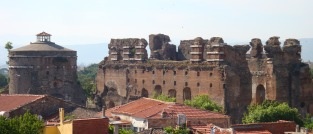 The first of the two sites, the Acropolis, is clearly visible ringing a hill to the north of Bergama. This was the location of a great library of 200,000 volumes built up by King Eumenes II (r.197-160 BC) in an attempt to rival the more famous one in Alexandria in Egypt. Nowadays it’s hard to imagine how much angst and jealousy this venture generated, but so worried were the Egyptians that the Pergamene library might steal their thunder that they actually banned the export of papyrus to Asia Minor in an attempt to stop the production of any more books.
The first of the two sites, the Acropolis, is clearly visible ringing a hill to the north of Bergama. This was the location of a great library of 200,000 volumes built up by King Eumenes II (r.197-160 BC) in an attempt to rival the more famous one in Alexandria in Egypt. Nowadays it’s hard to imagine how much angst and jealousy this venture generated, but so worried were the Egyptians that the Pergamene library might steal their thunder that they actually banned the export of papyrus to Asia Minor in an attempt to stop the production of any more books.
They’d reckoned without the wiliness of the Pergamenes, however, since they quickly set to work to come up with an alternative, a form of parchment made out of finely pressed animal hides (pergamena) that enabled the creation of the first actual books as opposed to scrolls.
Of course Alexandria won in the end anyway when the besotted Mark Anthony donated all the Pergamene books to his lover, Queen Cleopatra of Egypt. They survived until the seventh century when they were probably burnt.
Pergamum actually owed its importance to the break-up of Alexander the Great’s empire when the site fell to one of his generals, Lysimachus, who needed somewhere to stow his riches and thought the site of the Acropolis looked suitably easy to defend. The booty safely secured, he rode on to fight with another of Alexander’s generals, Seleucus, for control of the rest of Asia Minor. When he died in the course of the fighting in 281 BC, his treasurer Philetarus moved in to take his place, although, as a eunuch, he had no son to succeed him. Instead his nephew Eumenes I eventually took over, thereby establishing the dynasty that would govern Pergamum until Attalus III bequeathed it to the Romans in 129 BC.
Around town
Up on the Acropolis there is still plenty to see, most famously a jaw-droppingly steep theatre that could have seated an audience of 10,000 and which was cut into the contours of the hillside. Recently it has started staging theatrical performances again in summer.
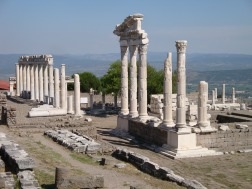 Conspicuous, too, are the remains of a later temple to the Emperor Trajan, which was reused as a cistern in the Middle Ages.
Conspicuous, too, are the remains of a later temple to the Emperor Trajan, which was reused as a cistern in the Middle Ages.
A path winds round the site and back down to the town. On its way it passes the location of a vast Altar of Zeus that used to be adorned with friezes depicting a fight between the gods and giants of Ancient Greek mythology. Unfortunately, these were removed by German archaeologists in the 19th century, and now adorn the Pergamon Museum in Berlin.
The Acropolis has been made much more accessible by the provision of a cable-car to carry visitors up to the site.
The Asclepion, to the south-west of town, is primarily a Roman site, approached along the remains of what must once have been a busy street of shops.
Asclepius was the Graeco-Roman god of medicine, and the shrine here was set up by a man who had been cured of his ills after traveling to the Asclepion at Epidaurus in Greece. Patients who came here were apparently treated using a form of dream interpretation, but in the second century the physician Galen, who had been born in Pergamum, set up a proper clinic, which brought it great fame. Galen’s ideas about the circulatory system were so ahead of their time that they continued to form the basis for most medicine right through until the Renaissance.
Look out for the remains of a column decorated with snakes which is still a symbol for surgeons – patients were seen as shedding their illnesses in the same way that a snake sheds its old skin.
Some of the finds from both sites are on display in Bergama Museum (closed Mondays), along with a magnificent statue of Aphrodite dredged from the mud at nearby Allianoi, an ancient thermal resort recently drowned by the Yortanlı Dam.
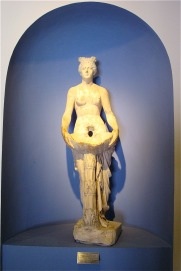 A third site is fairly unmissable. The Kızıl Avlu (Red Basilica) probably started life as a temple to the Egyptian gods Isis, Serapis and Harpocrates in the second century but went on to be regarded as one of the Seven Churches of the Apocalypse. A huge, brooding structure, it’s flanked by twin rotundas, one of which now houses the intriguing Kurtuluş Cami. The second houses a few fairly uninspiring finds from the site.
A third site is fairly unmissable. The Kızıl Avlu (Red Basilica) probably started life as a temple to the Egyptian gods Isis, Serapis and Harpocrates in the second century but went on to be regarded as one of the Seven Churches of the Apocalypse. A huge, brooding structure, it’s flanked by twin rotundas, one of which now houses the intriguing Kurtuluş Cami. The second houses a few fairly uninspiring finds from the site.
Restoration of the Kızıl Avlu (now signposted as Bazilika) has made the site both more interesting and easier to understand.
That’s all that most short-stay visitors see of Bergama, although much of the attractive old Greek neighbourhood that lay to the north of town until the 1924 population exchange still survives and repays a quick wander. The narrow streets are packed with attractive stone houses much like those in Ayvalık and Yeni Foça although gentrification has been slower to take off here. The local authorities are taking a belated interest in the area, relaying some of the cobbles and expensively renovating one of the houses near the Odyssey Guesthouse. Another newly converted building houses the Bergama Ticaret Odası Sosyal Tesisleri (Bergama Chamber of Commerce Social Facilities), not a name to trip off the tongue but one of the few really inviting places to eat.
The Belediye has also renovated the old Arasta (bazaar), the heart of the shopping area in the northern part of town. Two ancient hamams, the Merkez Hamamı and the Küplü Hamamı, have also been restored although neither was welcoming bathers on my last visit. The huge alabaster jars at the back of Ayasofya in İstanbul apparently came from the latter hamam.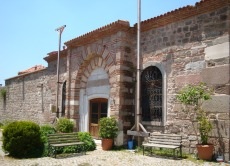
It’s worth strolling as far as the Kurşunlu Cami opposite the post office to look at two fine 19th-century buildings that house government offices: the Emniyet Müdürlüğü and the Milli Eğitim Müdürlüğü. The latter is especially beautiful with fine Neoclassical details around both doors and windows. Nearby, the 19th-century stone-built Yabets Synagogue, destroyed by fire in the 1940s, was restored in 2014 although its Sephardic congregation is long gone.
Eating
Bergama remains short of decent restaurants. In the older part of town a handful of tiny lokantas do a great lunch-time trade but then close early. The bigger places are a much longer walk away, past the site of the old otogar which is being turned into a cultural centre. There are no lovely cafes grouped around the main square and on a Sunday evening almost everything closes down. Kahve Diyarı is way out of the way in the shopping mall back towards the new otogar.
Sleeping
Akropolis Guesthouse. Tel: 0232-631 3420
Böblingen Pension. Tel: 0232-633 2153
Hotel Anıl. Tel: 0232-631 1830
Odyssey Guesthouse. Tel: 0232-653 9189
Transport info
There are hourly buses from İzmir to Bergama, and regular buses from nearby Ayvalık.
The new otogar is an inconvenient seven km south of town. Half-hourly servis buses run there from the Soma Garajı near the Kızil Avlu.
Minibuses from İzmir usually drop people off in the old part of town, making them more convenient than the big buses for many visitors.
The Eski Garaj in the old part of town offers bus services to Soma.
The cable-car that takes visitors direct from the old Greek quarter of town up to the Acropolis may not be beautiful but it has made getting around Bergama much easier. Expect long waits in summer when the tour groups gather. 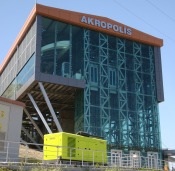
Day trip destinations


